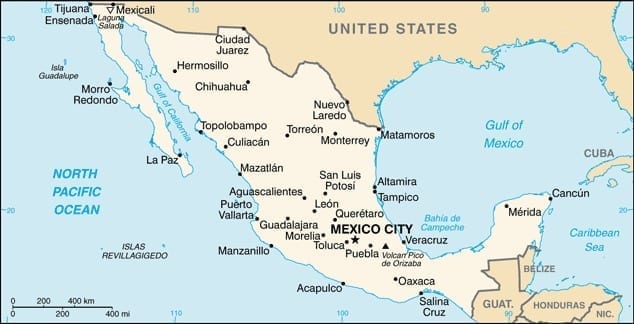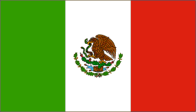Full Name: United Mexican States
National Symbol: Eagle on a cactus eating a snake
Internet Domain: .mx
International Dialing Code: +52
| General Info | Comparative Indicators |
| Location and Size | Credit and Collections |
| Government | Risk Assessment |
| Legal System | Business Climate |
| Interesting Facts | Business Protocol |
| Economy | Other Sources of Info |
12345
Location and Size
Mexico is located in southernmost North America. It borders the Caribbean Sea and the Gulf of Mexico on the east; the Pacific Ocean on the west; the U.S. to the north; and Belize and Guatemala to the south. Its territory covers a total of 1,964,375 sq. km., making it slightly less than three times the size of Texas. Mexico City, its capital, is located in south central Mexico.
Government
Mexico is a federal presidential republic comprised of thirty-two states and one federal district.
Branches:
- Executive: Chief of State and Head of Government – President Andres Manuel LOPEZ OBRADOR; Cabinet – appointed by the president
- Legislative: Bicameral National Congress consists of the Senate (128 seats) and the Chamber of Deputies (500 seats)
- Judicial: Supreme Court of Justice; justices appointed by the president with consent of the Senate.
Legal System
Mexico has a civil law system with US constitutional law theory influence and judicial review of legislative acts.
Mexico accepts compulsory International Court of Justice (ICJ) jurisdiction. It also accepts International Criminal Court (ICC) jurisdiction.
Ten Interesting Facts About Mexico
- Mexico introduced chocolate, corn, and chilies to the world.
- The National University of Mexico was founded in 1551 by Charles V of Spain and is the oldest university in North America.
- The red poinsettia flower originated in Mexico. It is named after U.S. ambassador to Mexico, Joel Roberts Poinsett, who served in the 1820s.
- Mexico City is built over the ruins of a great Aztec city, Tenochtitlán. Because it is built on a lake, it is sinking at a rate of 6 to 8 inches a year as pumps draw out water for the city’s growing population.
- When Spanish Conquistador Hernan Cortés arrived in 1519, the Aztecs believed he was their returning god, Quetzalcoatl, and offered him the drink of the gods: hot chocolate.
- Spanish conquerors brought bullfighting to Mexico, which is now the country’s national sport.
- The Chichen Itza Pyramid in Mexico was named one of the new Seven Wonders of the World.
- Mexico is the sixth-largest oil producer in the world, with a daily production of nearly 4 million barrels.
- Mexico has 707 species of reptiles, 438 species of mammals, 290 species of amphibians, and about 26,000 species of flora.
- Per capita, Mexico drinks more Coca-Cola than any other country.
Economy
Mexico has the second largest economy in Latin America. The outlook for the Mexican economy is favorable. The government has recently expanded competition in seaports, railroads, telecommunications, electricity generation, natural gas distribution, and airports. The banking system is sound and economic stability has been maintained.
Mexico is dependent on foreign trade, which represents approximately 60% of its GDP. Its economic activity is heavily linked to the United States, which accounts for 78% of its exports. Its industrial production, particularly assembly work, is also closely correlated to economic activity in the U.S.
Mexico’s vast market of more than 112 million inhabitants, together with its participation in trade promoting organizations is supportive of future economic growth. However, deficiencies in infrastructure, education, research and justice, as well as poor development of business credit, pose challenges.
Leading Markets (2020): United States 79.9%
Leading Exports – Commodities: Manufactured goods, oil and oil products, silver, fruits, vegetables, coffee, cotton
Leading Suppliers (2020): US 46.4%, China 17.7%, Japan 4.3%
Leading Imports – Commodities: Metalworking machines, steel mill products, agricultural machinery, electrical equipment, car parts for assembly, repair parts for motor vehicles, aircraft, and aircraft parts
Top Industries: Food and beverages, tobacco, chemicals, iron and steel, petroleum, mining, textiles, clothing, motor vehicles, consumer durables, tourism
Top Agricultural Products: Corn, wheat, soybeans, rice, beans, cotton, coffee, fruit, tomatoes, beef, poultry, dairy products, wood products
Comparative Economic Indicators ” 2020
| Mexico | Belize | El Salvador | Guatemala | Honduras | USA | |
| Population (millions) | 128.6 | 0.3 | 6.4 | 17.1 | 9.2 | 332.6 |
| Population growth rate (%) | 1.0 | 1.72 | 0.83 | 1.9 | 1.2 | 0.72 |
|
Age Structure (%)
(15 to 64 years old)
|
66.3 | 62.9 | 66.5 | 61.6 | 64.4 | 53.69 |
|
Age Structure (%)
(65+ years old)
|
7.67 | 4.53 | 7.2 | 4.7 | 5.4 | 16.85 |
| Literacy (%)* | 95.4 | 76.9 | 88.5 | 81.5 | 87.2 | 99.0 |
| Unemployment rate (%)* | 3.4 | 11.3 | 7.0 | 2.3 | 5.6 | 4.4 |
| Inflation (%)* | 2.8 | 1.1 | 1.0 | 4.4 | 3.9 | 2.1 |
| Population below poverty line (%)* | 46.2 |
41.0
|
32.7 | 59.3 | 29.6 | 15.1 (2010 est.) |
| GDP** (USD trillion)* | 2.46 | 3.21 (Bn) | 51.17 (Bn) | 138.1 (Bn) | 46.3 (Bn) | 19.49 |
| GDP real growth rate (%)* | 2.0 | 0.8 | 2.3 | 2.8 | 4.8 | 2.2 |
| GDP per capita** (USD)* | 19,900 | 8,300 | 8,000 | 8,200 | 5,600 | 59,800 |
| Public debt (% of GDP)* | 54.3 | 99.0 | 67.9 | 24.7 | 39.5 | 78.8 |
| Exports (USD billions)* | 409.8 | 0.4 | 4.6 | 11.1 | 8.6 | 1,553.0 |
| Imports (USD billions)* | 420.8 | 0.8 | 9.4 | 17.1 | 11.3 | 2,361.0 |
| Currency | Peso MXN |
Dollar BZD |
Dollar USD |
Quetzal GTQ |
Lempira HML |
Dollar USD |
| Exchange rates (per USD) 09/21/2020 | 21.35 | 2.02 | n/a | 7.77 | 24.67 | n/a |
| Exchange rates (per EUR) 09/21/2020 | 25.14 | 2.37 | 1.18 | 9.15 | 29.04 | 1.18 |
Economic Data from CIA World Factbook
* 2019 Estimate
Credit and Collections
Mexican Statutes of Limitations:
- Open Account: 4 years
- Promissory Notes: 3 years
- Written Contracts: 4 years
- Oral Agreements: 4 years
Dispute Resolution:
As a participant in USMCA, Mexico subscribes to its regulations pertaining to dispute resolution.
Chapter 17 of USMCA contains commitments to liberalize financial services markets and facilitate a level playing field for U.S. financial institutions, investors and investments in financial institutions, and cross-border trade in financial services. The chapter also preserves the discretion of financial regulators to ensure financial stability.
From the Office of the United States Trade Representative, key achievements within the financial services chapter include obligations to prevent discrimination against U.S. financial services suppliers, alongside a first-ever provision against local date shortage requirements, wherein a financial regulator has the access to data that it needs to fulfill its regulatory and supervisory mandate.
Risk Assessment
Coface Country Rating: C— High risk
Coface Business Climate Rating: A4— Reliability and availability of company reports vary. Debt collection often difficult.
Coface Country Rating: The overall risk is a combination of business-specific factors and factors relating to the country in which the business operates. The analyses use a seven-level ranking. In ascending order of risk, these are: A1, A2, A3, A4, B, C and D.
Coface Business Climate Rating: Evaluating the business environment involves measuring the quality of a country’s private sector governance ” in other words businesses’ financial transparency and the effectiveness of the courts in settling debts. Evaluations use a seven-level ranking. In ascending order of risk these are: A1, A2, A3, A4, B, C and D.
Business Climate
Mexico is open to foreign direct investment (FDI) in most economic sectors and has consistently been one of the largest recipients of FDI among emerging markets.
Despite Mexico’s relatively open economy, a number of key sectors in Mexico continue to be characterized by a high degree of market concentration. These include telecommunications, electricity, television broadcasting, petroleum, beer, cement, and tortillas which feature one or a few dominant companies with enough market power to restrict competition. In support of smaller enterprises, state governments have passed small business facilitation measures, making it easier to open businesses.
As a free market economy comprised of modern and outmoded industry and agriculture, it is becoming increasingly dominated by the private sector.
Economic Freedom: Mexico’s economic freedom score is 66.0, making its economy the 67th freest in the 2020 Index of Economic Freedom.
Market Access: Mexico has free trade agreements with over 50 countries including Guatemala, Honduras, El Salvador, the European Free Trade Area, and Japan – putting more than 90% of trade under free trade agreements.
The Mexican government is currently developing an International Trade Single Window to simplify import, export, and transit-related operations, increase efficiency and reduce costs and time for international traders.
Corruption: According to Transparency International’s 2019 Corruption Perceptions Index, Mexico scored 29 on a scale of 1 to 100, where lower numbers represent a greater perception of corruption. Corruption is pervasive at almost all levels of the Mexican government and society. Aggressive investigations and operations have exposed corruption at the highest levels of government. The government has enacted strict laws attacking corruption and bribery, with average penalties of five to ten years in prison.
Political Violence: While political violence is rare, narcotics and organized crime-related violence have skyrocketed. Transnational criminal organizations (TCOs) fighting each other and the government for control of drug smuggling routes have carried out violent acts unprecedented both in number and nature. Institutions, including major media outlets and a U.S. Consulate, have been subject to unprecedented attacks. TCOs continue to expand their operations into any available money-making venture, often targeting business owners and others innocent of any involvement in narcotics trafficking.
Business Protocol in Mexico
- It’s important that your initial delegation include an upper-level executive as the initial meeting will generally be with someone of high stature.
- Business appointments are required and should be made at least 2 weeks in advance.
- It’s important that you arrive on time for meetings, although your Mexican business associates may be up to 30 minutes late.
- Expect to answer questions about your personal background, family, and life interests.
- Have all written material available in both English and Spanish.
- Negotiations and decisions take a long time and will include a fair amount of haggling. Do not give your best offer first and do not include an attorney on your negotiating team.
- Men should wear conservative, dark-colored suits; women, business suits or conservative dresses.
- Business cards are exchanged during introductions with everyone at a meeting. Have one side in Spanish.
Sources for further information on doing business in Mexico
United States-Mexico Chamber of Commerce
**********
Subscribe to the Credit-to-Cash Advisor
Monthly e-Newsletter — It’s Free
This information is provided by ABC-Amega Inc. Providing international receivable management and debt collection services for exporters to more than 200 countries including Mexico. For further information, contact [email protected].
This report represents a compilation of information from various reputable sources.
Comparative Economic Indicators: CIA World Factbook

